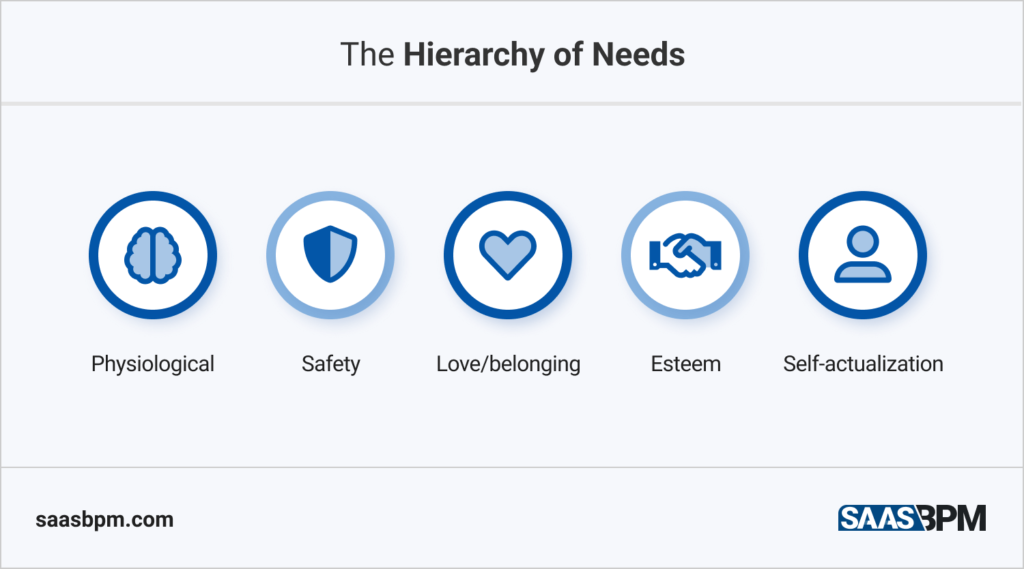Team productivity and optimal time management have long been at the core of business strategy. Every business leader constantly seeks ways to motivate their employees to do more and exceed performance expectations.

There are countless articles full of different team productivity tips and team motivation out there. However, the key is to find what works best for your team and the individuals in it.
In this article, we will explain how team productivity has been affected by the remote work model. Also, we will dive into different psychological theories to stimulate efficiency. In addition, we have included some practical steps to implement in your organisation.
Maslow’s Hierarchy of Needs
Maslow’s Hierarchy of Needs, born in 1943, is a team productivity theory by the psychologist Abraham Maslow. It presents the needs of a person as a pyramid of 5 levels. Each of them should be fulfilled before the next one. They are: Physiological (food, shelter, nourishment), Safety (health, security, wellbeing) and Love/belonging (build close relationships). The last two levels are Esteem (the need of confidence and respect), and Self-actualization (the need to overachieve and develop).

According to the theory, an individual can be productive and motivated to achieve the most they can if they are healthy, safe, secure and in an environment of meaningful people.
Therefore, team productivity can increase only when employees of a company are in good health and feel safe and secure. If you impose fear, control and disrespect over them, stress about reaching the monthly targets and deadlines, you can’t expect your team to be motivated to push themselves to work harder.
In this day and age the remote work model is at its prime. Therefore, employers need to give their teams extra boosts to motivate and inspire them. Make sure the workspace, virtual or not, is a secure space where people are not afraid to express their concerns and ask for support. Also, if you choose this theory to guide you to success, watch out for needs such as flexible hours and financial perks (financial security is part of the Safety level). If these could be the keys to optimized team productivity, use them to your benefit.
The Hawthorne Effect
The Hawthorne Effect team productivity theory dates from 1950 and was introduced by Henry A. Landsberger.
According to his research, people work harder when they are being watched. This is also the case when there are physical changes in their environment that keep them accountable.

During the series of social experiments that lead to the formation of this theory, researchers noticed an interesting phenomenon. Despite changes in lighting, working hours and breaks, the attention they paid on the employees was actually the booster for their enhanced performance.
Hence, as an employer or a team leader, you need to make sure you pay attention to what tasks your staff is working on. Stay tuned in their workflows at all times. In the world of remote work, this is fairly easy with business tech tools such as a business process management software. A BPM solution makes all processes in an organisation transparent and similarly structured. If you are a freelancer, you may experiment to work at a coworking space. As a result, you can see if being surrounded by other freelancers pushes you to be more productive.
The Reinforcement Theory of Motivation
The reinforcement theory of motivation was first introduced by B.F. Skinner and Ivan Pavlov. Its main idea is that positive consequences dictate productive behaviour.
According to this team productivity theory, employees who get a reward after doing something positive would have enough encouragement to push themselves more. This is so they keep receiving positive feedback. On the other hand, if you do not positively react to an employee’s good performance, it’s unlikely for them to have the drive to do well again.

Employers can apply the reinforcement theory in four ways: positive/ negative reinforcement, punishment and extinction. However, it may be difficult for managers to determine the types of behaviour that deserve an award. Nevertheless, it’s important to be vocal about what behaviour is desirable and what is not from the onboarding process if possible.
For example, an employee does their work before the deadline As a result, you can positively reinforce them by praising them in a meeting, giving them a bonus or by simply thanking them about their responsibility. This employee would likely continue planning his tasks ahead of time to stay on point.
However, if a team member always fails to meet their targets, you may request daily reports which they will for sure not like. This would be an example of negative reinforcement. The employee will try their best to demonstrate their ability to manage their time so the need for daily reports disappears.
The Three-Dimensional Theory of Attribution
Bernard Weiner invented the Attribution theory and explored how people attribute meaning to their behaviour.
There are three dimensions of an attribution and what matters for future behaviour is how we define it. They are stability, locus of control and controllability.
For example, an employee is late for work. They may accept the reason (attribution) is the bad traffic because of a road accident. If that’s the case, it is an out-of-the ordinary event that is unlikely to affect that employee’s motivation to get to work on time in future. However, if they (or their manager) attribute it to their poor organisational skills, that may be something they need to work on.

In a remote work setting, it may be difficult to point your finger at the attribute for a particular type of behaviour, such as procrastination. Therefore, it’s important to schedule regular feedback sessions and appraisals with your team. That’s how you will stay on track with their project management skills.
4 Psychological Theories On Team Productivity – Final Thoughts
Team productivity has always been the hot topic in management. There are different psychological theories about enhancing team efficiency. Employers use in order to tackle poor behaviour as well as praise positive results. It is all a matter of keeping the communication going with your team. Also, making sure you show them your appreciation, give them security and understanding is key.

